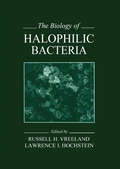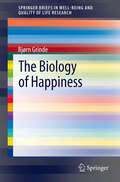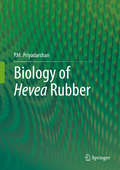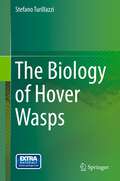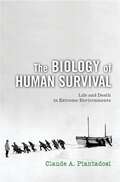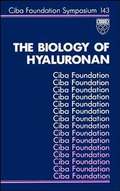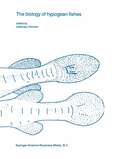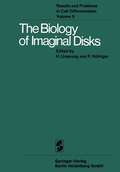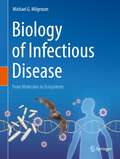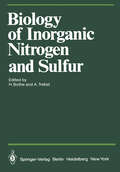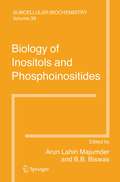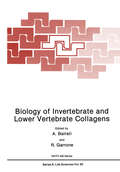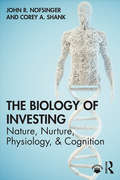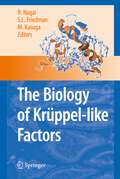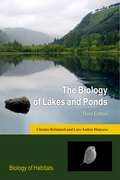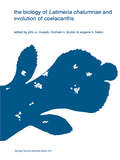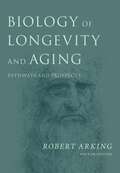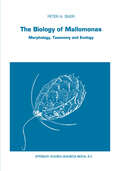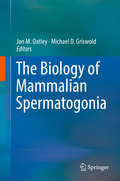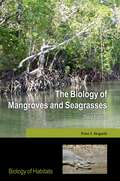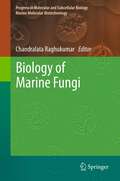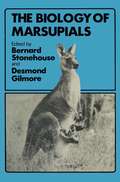- Table View
- List View
The Biology of Halophilic Bacteria (Microbiology Of Extreme And Unusual Environments Ser. #1)
by Russell H. Vreeland Lawrence I. HochsteinA book for anyone interested in halophilic bacteriaThe Biology of Halophilic Bacteria presents detailed information regarding methods for working with halophilic bacteria. Helpful hints for performing various tests and assays in high salts are given, and information about data presentation and analysis is provided as well. The book will be useful to molecular biologists, biochemists, ecologists, and others interested in halophilic bacteria.
The Biology of Halophilic Bacteria
by Russell H. Vreeland Lawrence I. HochsteinA book for anyone interested in halophilic bacteriaThe Biology of Halophilic Bacteria presents detailed information regarding methods for working with halophilic bacteria. Helpful hints for performing various tests and assays in high salts are given, and information about data presentation and analysis is provided as well. The book will be useful to molecular biologists, biochemists, ecologists, and others interested in halophilic bacteria.
The Biology of Happiness (SpringerBriefs in Well-Being and Quality of Life Research)
by Bjørn GrindeThe brief presents a model for happiness based on current knowledge in evolutionary biology and neurobiology. Briefly, the primary purpose of nervous systems is to direct an animal toward behaviour relevant for survival and procreation. In primitive animals actions are based on reflexes, while in humans the modules directing behaviour engage positive and negative affect (good and bad feelings), and they are swayed by cognitive processes. The reason why evolution opted for this strategy was the improved flexibility in response – i.e., we learn from previous experiences. The human capacity for happiness is an accidental consequence.An array of brain modules has evolved to care for various pursuits, but recent studies suggest that they converge on shared neural circuits designed to generate positive and negative mood. Happiness can be construed as the net output of the relevant modules. The briefs suggests a strategy for how to avoid having negative feelings (such as anxiety, depression and chronic pain) dominate the mind, and how to exercise positive feelings. In short, the book offers both a deeper understanding of what happiness is about, and a framework for improving well-being.An array of brain modules has evolved to care for various pursuits, but recent studies suggest that they converge on shared neural circuits designed to generate positive and negative mood. Happiness can be construed as the net output of the relevant modules. The book suggests a strategy for how to avoid having negative feelings (such as anxiety, depression and chronic pain) dominate the mind, and how to exercise positive feelings. In short, the book offers both a deeper understanding of what happiness is about, and a framework for improving well-being.
Biology of Hevea Rubber
by P. M. PriyadarshanIn the second edition of this book, the origin, upkeep and latex harvest from the Hevea rubber tree are dealt with succinctly. New chapters have been included on Propagation Systems and Genetic Resources. The importance of Heterozygosis and Breeding is a new theme for the section on Breeding. A new chapter on Genomics and Molecular Breeding that focuses on the latest advancements on gene mapping, marker assisted selection and stimulation has been added. Lastly, ‘textboxes’ that highlight points and topics of significant interest are included in the new addition.Natural rubber has been an essential commodity not only for the tire industry but also for more than 50,000 products that holds elasticity as an attribute. The prime source of natural rubber worldwide is Hevea brasiliensis. Hevea rubber tree is an excellent example of how a soil-tree-atmosphere system can work in tandem. The retrieval of rubber through ‘injuring’ the tree on alternate days or once in three days or once in seven days, is indeed a unique arrangement followed universally that ensures income to the planter almost throughout the year. Every molecule of rubber is the end result of meticulous biochemical changes. Therefore the biology of Hevea rubber tree itself is a subject that aggregates science and technology for the realization of its industrial utility.
The Biology of Hover Wasps
by Stefano TurillazziThis book represents the culmination of the author’s lifetime work on a single fascinating group of insects, the hover wasps, Stenogastrinae. The author explores the biology of these little-known wasps at the threshold of sociality, presenting an ambitious survey of ideas about their evolution and an assessment of the current standing of controversial concepts.Following taxonomic and morphological descriptions, the behaviour, colonial dynamics, social communication and especially the remarkably diverse nests of wasps are discussed. Compared to the better-known species of paper wasps, hornets and yellow jackets, the hover wasps show various peculiarities, such as characteristics of immature brood rearing, nest defence and mating systems. The nest architecture probably presents the most variable solutions in social wasps and is characterized by an astonishing level of camouflage, making these insects an interesting example of special adaptation to forest environments.
The Biology of Human Survival: Life and Death in Extreme Environments
by Claude A. PiantadosiThe range of environments in which people can survive is extensive, yet most of the natural world cannot support human life. The Biology of Human Survival identifies the key determinants of life or death in extreme environments from a physiologist's perspective, integrating modern concepts of stress, tolerance, and adaptation into explanations of life under Nature's most austere conditions. The book examines how individuals survive when faced with extremes of immersion, heat, cold or altitude, emphasizing the body's recognition of stress and the brain's role in optimizing physiological function in order to provide time to escape or to adapt. In illustrating how human biology adapts to extremes, the book also explains how we learn to cope by blending behavior and biology, first by trial and error, then by rigorous scientific observation, and finally by technological innovation. The book describes life-support technology and how it enables humans to enter once unendurable realm, from the depths of the ocean to the upper reaches of the atmosphere and beyond. Finally, it explores the role that advanced technology might play in special environments of the future, such as long journeys into space.
The Biology of Hyaluronan (Novartis Foundation Symposia #143)
by David Evered Julie WhelanPresents state-of-the-art applications in hyaluronan research, from hyaluronan's physicochemical properties to its clinical role as a connective tissue marker and its surgical implications, particularly in ear, eye and orthopaedic surgery. Covers hyaluronan's synthesis and catabolism, its role in cells, its interactions with specific binding proteins, and its role in the embryonic nervous system.
The biology of hypogean fishes (Developments in Environmental Biology of Fishes #21)
by Aldemaro RomeroHypogean (cave, artesian) fishes have fascinated researchers even before they were described in the scientific literature in 1842. Since then, a number of scientists have used them to justify their own evolutionary ideas, from neo-Lamarckism to neo-Darwinism, from neutral evolution to selectionist approaches. Research in recent years has shown that these fishes are much more complex in their adaptations to the subterranean environment than previously believed: there are those with features expected from living in total darkness (complete blindness and depigmentation) and poor in nutrients (extremely low metabolic rates); others differ very little, if any, from their epigean (surface) ancestors in their morphology and physiology (but not so in their behavior). Some of them even live in nutrient-rich environments. Actually, one of the most overlooked facets of these animals is that there are more species of hypogean fishes without troglomorphisms (blindness, depigmentation) than with troglomorphic ones. The study of these apparently `unadapted' fishes is providing new insights into our understanding of the evolution of phenotypic characters, founding effect, behavioral, and physiological adaptations. The 86 species of troglomorphic fishes described so far belong to 18 different families, many of which would hardly fit the notion that they were 'preadapted' to conquer the underground environment. Further, many troglomorphic `species' show very little genotypic differentiation when compared with their putative ancestors, indicating that massive phenotype changes can be achieved via little genetic reorganization, a reorganization that mostly affects regulatory genes. These and many other topics are discussed in this volume containing 29 papers, written by 41 authors from 9 countries. Hopefully, this volume will convince many other researchers that hypogean fishes represent a unique opportunity to study a concept in evolutionary biology that is only superficially understood: convergent evolution.
The Biology of Imaginal Disks (Results and Problems in Cell Differentiation #5)
by H. Ursprung R. Nöthiger~o working hypothesis amounts to much until it has been tested on suitable material. Indeed, the choice of an appropriate experimental system has often been the key to the solution of a problem. The present volume is devoted to insect imaginal disks. These groups of larval cells are the primordia of precisely characterized adult counterparts, without apparent function in larvae. At the onset of metamorphosis, the subtle interplay of hormonal signals brings growth to a halt, and differentiation begins. In the fruitfly, a host of mutations are known to affect the development of disks; these provide ample material for analysis. It was largely ERNST HADORN'S ingenuity that directed the attention of many scientists around the world to this promising experimental system, and to him this volume is dedicated. All the contributors have been associated with him at one time or another, as graduate students, postdoctoral fellows, or colleagues. Each author has attempted to cover comprehensively the topic assigned to him. This has inevitably led to some overlapping, for which the editors should be blamed, not the authors, as this results from the way the topic was subdivided at the outset. We believe this volume will be a welcome sourcebook for the specialist in the field, and a provocative monograph for the uninitiated scientist interested in the exciting area of cell determination.
Biology of Infectious Disease: From Molecules to Ecosystems
by Michael G. MilgroomThis textbook provides a broad introduction to the biological processes underlying infectious diseases in a range of hosts and pathogens. The text covers topics at all levels of biological organization, from the molecular and cellular level, organismal level, and population and ecosystem level, and goes well beyond infectious diseases of humans. The details of how microbes interact with their hosts are unique for each interaction, but emphasis is on the common principles of host-pathogen interactions that result in disease. Biology of Infectious Disease: From Molecules to Ecosystems is aimed at undergraduate and early graduate-level students in biology or public health, including pre-medical and pre-public-health students, who are interested in a broad introduction to infectious disease but do not have any previous background in microbiology or immunology.
Biology of Inorganic Nitrogen and Sulfur (Proceedings in Life Sciences)
by H. Bothe A. TrebstNitrogen and sulfur compounds are continuously synthetized, degraded and converted into other forms in nature. There are many similarities in the principle problems and basic mechanisms of the biology of inorganic nitrogen and sulfur. Many details are not yet understood and hence are the subject of active investigation the world over. In May, 1980, a conference was held in Bochum, Federal Republic of Germany, at which attempts were made to discuss and compare all aspects of both the nitrogen and the sulfur cycle. Lectures were given by internationally recognized experts on the physiology, biochemistry, genetics, and ecology of dinitrogen fIXation, of assimilatory and dissimilatory nitrate and sulfate reduction, and of ammonia and sulfide oxidation. In addition, important data were communicated by German scientists of the national program on the Metabolism of Inorganic Nitrogen and Sulfur Compounds, supported by the Deutsche Forschungsgemeinschaft. This book contains all the contributions to the meeting and consequently should be of interest to researchers, teachers, and students in the field. The members of the German national program on the Metabolism of Inorganic Nitrogen and Sulfur Compounds would like to thank the Deutsche F orschungsgemeinschaft for their generous fmancial support of the scientific projects during the past four years and for the conference itself. Without this help, the present book would not have been written. The members express their appreciation particularly to Dr. A. Hoffmann of the Deutsche Forschungsgemeinschaft for her invaluable skill and patience in taking care of the projects and scientists.
Biology of Inositols and Phosphoinositides: (pdf) (Subcellular Biochemistry #39)
by A. Lahiri Majumder B. B. BiswasBiology of Invertebrate and Lower Vertebrate Collagens (Nato Science Series A: #93)
by A. BairatiKnowledge in the field of the biology of the extracellular matrix, and in particular of collagen, has made considerable progress over the last ten years, especially in mammals, birds and ln man with respect to very important applied medical aspects. Basic knowledge in the animal kingdom overall has increased more slowly and haphazardly. We, therefore, considered it useful to organize a meeting specifically devoted to the study of the invertebrate and lower vertebrate collagens. The NATO Scientific Division financed an Advanced Research Workshop aimed at bringing together experts qualified in collagen biology (with morphological, biochemical and genetic specialization) with researchers who are currently studying collagenous tissues of invertebrates and lower vertebrates. The Medical-Biology Committee of the CNR-Rome and the University of Milan also supplied interest and support for the organization of this Meeting. The format of the workshop consisted in: 1) main lectures on the most recent aspects of collagen biology; 2) minireviews on the current knowledge of collagenous tissues in the various invertebrate phyla and in fish; 3) contributed papers on particular aspects of research in specific fields; 4) workshops on the methodology of studying collagen. As we had intended, the Workshop gave a comprehensive overview of acquired knowledge and of the present state of research actlvlty. It permitted wide interdisciplinary discussion, enabling collabora tions to be established and new research themes to be chosen. This volume contains the text of all the contributions presented at the Meeting, including posters.
The Biology of Investing
by John R. Nofsinger Corey A. ShankWhy do people’s financial and economic preferences vary so widely? ‘Nurture’ variables such as socioeconomic factors partially explain these differences, but scientists have been discovering that ‘nature’ also plays an important role. This is the first book to bring together these scientific insights for a holistic view of the role of human biology in financial decision-making. Geneticists are now examining which genetic markers are associated with financial and economic preferences. Neuroscientists are now determining where in the brain financial decisions are made and how that varies between people. Endocrinologists relate the level of different hormones circulating in the body to financial risk-taking. Researchers are exploring how physiology and environmental conditions influence investment decisions, and how three types of cognitive ability play essential roles in investment success. This exciting and relevant work being done in these academic silos has generally not been transmitted among the scientific areas, or to industry. For the first time, this book integrates all these areas, explaining the myriad ways in which a person’s biology influences their investing decisions. Financial analysts, advisors, market participants, and upper-level undergraduate and postgraduate students of behavioral finance, behavioral economics, and investing will find this book invaluable, enabling a deeper understanding of investors’ decision-making processes. To further ensure this new material is accessible to students, PowerPoint slides are available online for instructors’ use.
The Biology of Investing
by John R. Nofsinger Corey A. ShankWhy do people’s financial and economic preferences vary so widely? ‘Nurture’ variables such as socioeconomic factors partially explain these differences, but scientists have been discovering that ‘nature’ also plays an important role. This is the first book to bring together these scientific insights for a holistic view of the role of human biology in financial decision-making. Geneticists are now examining which genetic markers are associated with financial and economic preferences. Neuroscientists are now determining where in the brain financial decisions are made and how that varies between people. Endocrinologists relate the level of different hormones circulating in the body to financial risk-taking. Researchers are exploring how physiology and environmental conditions influence investment decisions, and how three types of cognitive ability play essential roles in investment success. This exciting and relevant work being done in these academic silos has generally not been transmitted among the scientific areas, or to industry. For the first time, this book integrates all these areas, explaining the myriad ways in which a person’s biology influences their investing decisions. Financial analysts, advisors, market participants, and upper-level undergraduate and postgraduate students of behavioral finance, behavioral economics, and investing will find this book invaluable, enabling a deeper understanding of investors’ decision-making processes. To further ensure this new material is accessible to students, PowerPoint slides are available online for instructors’ use.
The Biology of Krüppel-like Factors
by Ryozo Nagai Scott L. Friedman Masato KasugaKruppel-like factors (KLFs) are attracting great attention across a wide spectrum of biological sciences and medicine because of their remarkable biological potency and the diversity of roles they play in the physiological and pathological changes of cells and tissues. This book is a comprehensive compendium of the latest research on the molecular mechanisms of KLFs, describing their roles in transcriptional regulation, cellular differentiation and development, the pathogenesis of the liver and cardiovascular systems and cancer, and generation of ES cells and iPS cells. As the only concise treatise written to date by leading experts in the field, it serves as an authoritative review of this family of molecules and is an essential reference for all who are interested in KLFs. The book also explores the potential of KLFs as targets for novel therapeutics and diagnostics, and will be invaluable in those fields.
The Biology of Lakes and Ponds (Biology of Habitats Series)
by Christer Brönmark Lars-Anders HanssonA concise but comprehensive introduction to the biology of standing waters (lakes and ponds). As with other books in the Biology of Habitats Series, the emphasis in this book is on the organisms that dominate freshwater environments. Management and conservation aspects are also considered. The first edition of the book published in 1998 with a second, revised edition in 2005. There has been significant development in the field since the last revision appeared, particularly in the ecology of lakes and ponds in subtropical and tropical areas, and a new revision of this now classic text is timely.
The biology of Latimeria chalumnae and evolution of coelacanths (Developments in Environmental Biology of Fishes #12)
by J. A. Musick Michael N. Bruton E. K. BalonBiology of Longevity and Aging: Observations and Principles
by Robert ArkingThe latest edition of Robert Arking's seminal text on the biology of aging takes on an extended title, since the field of gerontology has advanced to a point at which it is possible to separate the topic into two implicit subsets, longevity and aging. This multi-faceted description of the biology of aging guides the reader through increasingly interesting answers to seven fundamental questions: What is aging? Why do we age? What mechanisms support extended longevity? What determines the onset of senescence? What is the mechanistic basis of senescence? Why do humans live so long? And lastly, what pro-longevity societal interventions are needed? Inevitably, humans will age but there is no reason why we must suffer from age-related diseases. Aging and longevity are dependent on both genes and social environment. Our biology does not forbid the modulation of aging. What we really want to know is not so much about the biology of aging - which is basically a degenerative process - but rather about biological processes underlying the long term maintenance of our health. New chapters incorporate the latest developments in the field of gerontology. Research done since the previous edition was published has given us insight into how we may stay healthier longer.
The Biology of Mallomonas: Morphology, Taxonomy and Ecology (Developments in Hydrobiology #63)
by P.A. SiverThe Biology of Mammalian Spermatogonia
by Jon M. Oatley Michael D. GriswoldThis book provides a resource of current understandings about various aspects of the biology of spermatogonia in mammals. Considering that covering the entire gamut of all things spermatogonia is a difficult task, specific topics were selected to provide foundational information that will be useful for seasoned researchers in the field of germ cell biology as well as investigators entering the area. Looking to the future, the editors predict that the foundational information provided in this book -- combined with the advent of new tools and budding interests in use of non-rodent mammalian models -- will produce another major advance in knowledge regarding the biology of spermatogonia over the next decade. In particular, we anticipate that the core molecular machinery driving different spermatogonial states in most, if not all, mammals will be described fully, the extrinsic signals emanating from somatic support cell populations to influence spermatogonial functions will become fully known, and the capacity to derive long-term cultures of SSCs and transplant the population to regenerate spermatogenesis and fertility will become a reality for higher order mammals.
The Biology of Mangroves and Seagrasses (Biology of Habitats Series)
by Peter J. HogarthMangroves and seagrasses form extensive and highly productive ecosystems that are both biologically diverse and economically valuable. This book, now in its third edition and fully updated throughout, continues to provide a current and comprehensive introduction to all aspects of the biology and ecology of mangroves and seagrasses. Using a global range of examples and case studies, it describes the unique adaptations of these plants to their exacting environments; the rich and diverse communities of organisms that depend on mangrove forests and seagrass meadows (including tree-climbing shrimps, synchronously flashing fireflies, and 'gardening' seacows); the links between mangrove, seagrass, and other habitats; and the evolution, biodiversity, and biogeography of mangroves and seagrasses. The economic value of mangroves and seagrasses is also discussed, including approaches to rational management of these vital resources and techniques for the restoration of degraded habitats. A final chapter, new to this edition, examines the potential effects of global climate change including sea level rise. As with other titles in the Biology of Habitats Series, particular emphasis is placed on the organisms that dominate these fascinating aquatic ecosystems although pollution, conservation, and experimental aspects are also considered. This accessible textbook assumes no previous knowledge of mangrove or seagrass ecology and is intended for senior undergraduate and graduate students, as well as professional ecologists, conservation practitioners, and resource managers.
The Biology of Mangroves and Seagrasses (Biology of Habitats Series)
by Peter J. HogarthMangroves and seagrasses form extensive and highly productive ecosystems that are both biologically diverse and economically valuable. This book, now in its third edition and fully updated throughout, continues to provide a current and comprehensive introduction to all aspects of the biology and ecology of mangroves and seagrasses. Using a global range of examples and case studies, it describes the unique adaptations of these plants to their exacting environments; the rich and diverse communities of organisms that depend on mangrove forests and seagrass meadows (including tree-climbing shrimps, synchronously flashing fireflies, and 'gardening' seacows); the links between mangrove, seagrass, and other habitats; and the evolution, biodiversity, and biogeography of mangroves and seagrasses. The economic value of mangroves and seagrasses is also discussed, including approaches to rational management of these vital resources and techniques for the restoration of degraded habitats. A final chapter, new to this edition, examines the potential effects of global climate change including sea level rise. As with other titles in the Biology of Habitats Series, particular emphasis is placed on the organisms that dominate these fascinating aquatic ecosystems although pollution, conservation, and experimental aspects are also considered. This accessible textbook assumes no previous knowledge of mangrove or seagrass ecology and is intended for senior undergraduate and graduate students, as well as professional ecologists, conservation practitioners, and resource managers.
Biology of Marine Fungi (Progress in Molecular and Subcellular Biology #53)
by Chandralata RaghukumarChandralata RaghukumarThe diversity, ecological role and biotechnological applications of marine fungi have been addressed in numerous scientific publications in the last few years. This enormous spurt of information has led to a dire need among students and professionals alike for a source, which contains comprehensive reviews of various aspects of marine fungi. This book addresses this need, especially since it is written by reputed marine mycologists. The latest information on topics including molecular taxonomy and phylogeny, ecology of fungi in different marine habitats such as deep sea, corals, dead- sea, fungi in extreme marine environments and their biotechnological applications is reviewed. The book presents a comprehensive source of information and analysis aimed at marine fungi for researchers, teachers and students of marine mycology.
